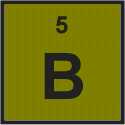Where Is Boron Found and How Is It Obtained
Elements for Kids
Boron
| |
|
Characteristics and Properties
Amorphous boron (meaning the atoms are bonded together in a random order) comes in the form of a brown powder.
Boron atoms can bond in a number of different types of crystal networks called allotropes. Crystalline boron is black in color and is extremely hard. The chemical compound boron nitride is the second hardest substance after diamond (which is an allotrope of carbon).
Boron tends to make covalent bonds rather than ionic bonds. It is a poor conductor at room temperature.
Where is boron found on earth?
Boron is a fairly rare element on Earth. Pure boron is not found naturally on Earth, but the element is found in many compounds. The most common compounds are borax and kernite which are found in sedimentary rock formations.
How is boron used today?
Most of the boron that is mined is eventually refined into boric acid or borax. Boric acid is used in a number of applications including insecticides, flame retardants, antiseptics, and to create other compounds. Borax is a powdered material used in detergents, cosmetics, and enamel glazes.
Boron is used in the manufacture of glass and ceramics. It produces high end cookware materials used in brands such as Duran and Pyrex. It also helps to make glassware for science labs.
Other applications that use boron include semiconductors (computer chips), magnets, super hard materials, and shielding for nuclear reactors.
How was it discovered?Boron was first discovered as a new element in 1808. It was discovered simultaneously by English chemist Sir Humphry Davy and French chemists Joseph L. Gay-Lussac and Louis J. Thenard. The first nearly pure boron was produced in 1909 by American chemist Ezekiel Weintraub.
Where did boron get its name?
The name boron comes from the mineral borax which gets its name from the Arabic word "burah".
Isotopes
Boron has two stable and naturally occurring isotopes. They are Boron-10 and Boron-11. There are thirteen known isotopes of the element.
Interesting Facts about Boron
- The largest borax mine in the world is located in Boron, California in the Mohave Desert.
- It burns with a green flame and is used to create green colored fireworks.
- Boron is an important mineral for plant life.
- It is generally not considered poisonous, but can be toxic in large doses.
- Some boron compounds such as borax have been used by ancient civilizations for thousands of years.
- The largest producers of boron minerals are Turkey, the United States, and Russia.
- Scientists think that boron has potential as a medicine to treat arthritis.
More on the Elements and the Periodic Table
Elements
Periodic Table
More Chemistry Subjects
Where Is Boron Found and How Is It Obtained
Source: https://www.ducksters.com/science/chemistry/boron.php
